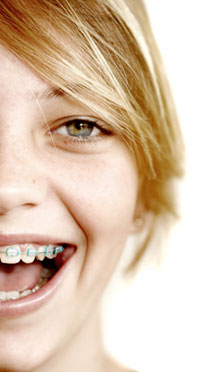Griffin Orthodontics David J. Griffin DDS MS LTD


Life with Braces
Life with Braces | Types of Braces | Types of Appliances | Palatal Expander | Braces Diagram
Oral Care Video | Retainers
Choose section:
Keeping a Healthy Smile
Braces create small ledges, nooks and crannies for food deposits, which can lead to cavities and gum problems. This makes brushing and flossing even more important while you are wearing braces. When you brush and floss, handle your appliances carefully so you won't break or loosen them. Following these brushing and eating tips will keep your appliances and your smile healthy.
Brushing
Be sure to brush your teeth right after every meal and before you go to bed. It's best to use a fluoride toothpaste to help fight cavities. Dr. Griffin may prescribe a special fluoride paste that you will brush with at night to help prevent cavities. Try to brush like this:
- Start by brushing the outside of each tooth at least 10 times.
- Then brush where your gums and teeth meet, using a circular motion.
- Brush the inside surface of each tooth at least 10 times.
- Brush the chewing surfaces of your teeth last.
Flossing
Because your toothbrush won't reach between your teeth, brushing alone won't keep your teeth clean and healthy. Flossing can help. A floss threader, available from us or a pharmacy, helps you floss with braces on. Floss once a day, like this:
- Thread floss through the threader and slip it up behind your archwire.
- Pull the floss between two teeth and up under your gum margins.
- Rinse with lots of clean water, and watch your teeth and braces sparkle.
Fluoride
Use a fluoridated toothpaste. Dr. Griffin may prescribe a special fluoride paste if necessary.
Remember
You should be brushing at least four times a day once at breakfast, at lunch, after school and before you go to bed. If you are not able to brush after you eat, be sure to rinse thoroughly with water, and NEVER skip brushing at night before you go to bed.
Eating with Braces
Although some patients are able to eat or drink almost anything while in braces and have no ill effects, there are certain dietary habits that are known to cause breakage of orthodontic appliances, as well as increase the risk of dental disease. Our aim is to achieve the treatment goals with as few disturbances due to appliance breakage as possible. Remember, teeth move their best in a healthy environment and in individuals with excellent overall health.
Potential Harm to Your Teeth and Gums
Foods and beverages that may cause dental cavities should be restricted while wearing braces. Sticky foods are to be avoided because of the increased risk of dental decay and appliance breakage. These foods stick to your braces and remain on your teeth for long periods of time. If foods or drinks high in sugar content are to be consumed, we advise having them with regular meals or at one given time of day. Please make sure that careful brushing and rinsing take place immediately afterwards. Between meals, snacks should be confined to foods without refined sugar and should be followed by vigorous rinsing if a toothbrush is not available.
The following foods can be particularly harmful to your teeth while wearing braces:
- Taffy and Caramels
- Soda Pop
- Sugar on Cereal
- Icing on Rolls or Cakes
- Peanut Butter and Jelly
- Catsup
- Syrup and Honey on Pancakes or Waffles
- Lemons (If eaten to often, the citric acid in the juice can dissolve tooth enamel.)
Potential Harm to Your Braces
Braces have been attached to your teeth with an adhesive that will normally withstand the forces of eating. However, braces can be dislodged and wires bent or broken while eating certain foods. Hard foods, such as nuts, hard candy, corn chips, and even crisp taco shells, can harm your braces and should be avoided. Chewing ice cubes can also be very destructive to your appliances. Some foods, such as whole apples, raw carrots or celery, are healthy snacks, but must be cut to avoid damaging your braces.
Chewy foods, such as gum, caramels, and even thick bread crusts, can bend and distort wires causing treatment delays and extra visits for repairs. Popcorn can cause harm in multiple ways. The husks from the popcorn can become lodged beneath the braces and cause irritation to the gum tissue. Unpopped kernels can shear or break off brackets as well as bend or dislodge wires. Please inspect your braces when eating foods that may become caught on the braces or beneath the gums.
Brushing and Flossing
The intended animation requires a newer version of Adobe Flash® Player. Please visit www.adobe.com to download the latest version.
Brushing: Step 1
Using a dry brush with a small amount of toothpaste place bristles where gums and teeth meet.
Brushing: Step 2
For 10 seconds on each tooth use circular, vibrating motions around the gum lines.
Brushing: Step 3
Every tooth of both arches should be brushed slowly.
Brushing: Step 4
Brush the lower teeth from the gum line up and the upper teeth from the gum line down. Brush the roof of your mouth and your tongue too!
Flossing: Step 1
Carefully thread unwaxed floss between braces and wire. You may find a floss threader helpful.
Flossing: Step 2
Carefully floss around the braces.
Flossing: Step 3
Carefully floss around the gum areas.
Flossing: Step 4
Carefully floss around each tooth.